UCLA Center for Community Schooling Research Practice Partnership Report 4-RPP-20
Creating Persistent Community
The Challenge of Aligning Supports for First-Generation College-going Students
November 30, 2020
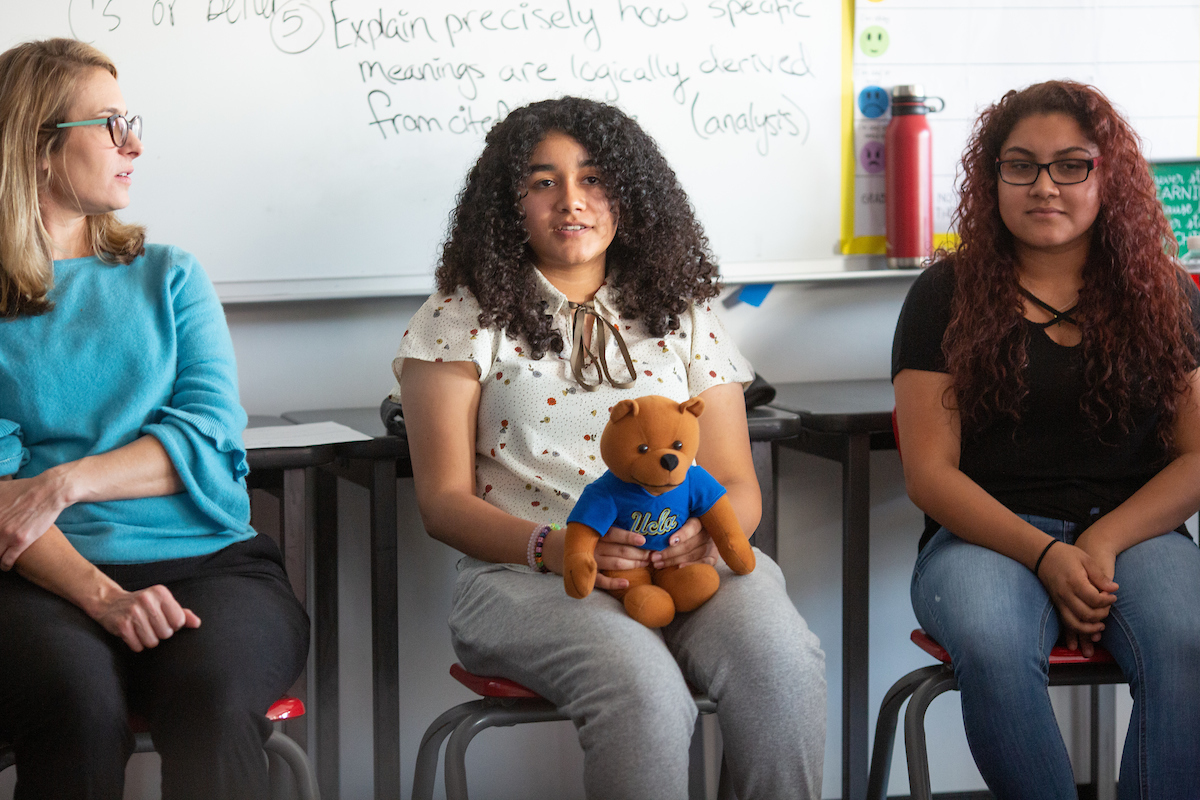
Acknowledgements
The authors would like to thank Cecilia Rios-Aguilar, Leyda Garcia, and Marisa Saunders for their thoughtful contributions to this report. In addition, Chasidy Potts, Beth Trinchero, and Agnes Cesare were enormously helpful in collecting alumni data and are constant sources of support for the school’s college going culture. Many of the ideas about persistent community developed as a result of rich conversations in the UCLA Community School’s research meetings and partnership retreats. Without the school’s collective wisdom, this report would not have been possible.
Executive Summary
Know that you are not alone. Share your challenges with people who can support you.”
Victoria Amador, First-generation College Graduate
Students like Victoria, from low-income, high-minority schools, face a long and steep road to college graduation. Only 55% enroll in college the fall after graduating from high school and only 27% complete college within six years. Economic hardship, institutional racism, and other pernicious societal inequities contribute to these outcomes. Longstanding disparities in college access and completion outcomes have focused policy attention on K-12 college preparatory schools that serve traditionally underrepresented students in higher education. This report shares longitudinal research from one of these schools, the UCLA Community School. Established in 2009 as a site of public scholarship, the school is helping to reshape public education in California by aligning primary, secondary, and higher education. The key, we argue in this report, is to create overlapping networks of support to better serve students traditionally underrepresented in higher education. We call this approach persistent community: building the relationships and resources that affirm students’ sense of belonging, community cultural wealth, and agency from Kindergarten through college graduation.
In this report, we study the experience of seven cohorts of students (n=597) from the UCLA Community School and track their pathways to and through college using four measures: (1) postsecondary plans, (2) immediate college enrollment, (3) college persistence (first to second year, and four-year pathways), (4) college completion (within six years). Overall, the school is preparing almost all graduates to enter college and college enrollment and initial persistence rates are higher than the national average. We also found that University of California (UC) students persist at higher rates than California State University (CSU) and community college students. Based on the first cohort of graduates, the Class of 2014, the six-year college completion rate is 31%, slightly higher than average for similar students (27%) but far below the national average (60%).
Given the school’s experience over the past decade, we believe that creating a sense of stability and connectedness for students during their formative years will prepare them to stay connected to their community and value the importance of giving and receiving support as members of different communities as they become adults. Yet, based on the challenges we know alumni have experienced persisting through college we are now asking questions about how the school can better prepare students to persist. This report analyzes the role of K-12 alumni support programs and questions the capacity of secondary schools to offer and sustain these supports, which often duplicate programs at the college level. We examine how high schools broker access to college support programs such as the CSU’s Education Opportunity Program (EOP) and discuss the potential of social media to network and support alumni. Based on in-depth interviews with alumni, we discuss the importance of honoring and harnessing familial capital as the foundation that supports students to enter, persist, and complete college. And we hold up three portraits of persistence, college graduates including Victoria, to learn from the success stories in the school’s own community. The report closes with the following recommendations:
For K-12 schools:
- Recognize the challenges your alumni will face and prepare them to understand and navigate these challenges by belonging to a persistent community of supporters, including their family. Broker access to the wide variety of supports and programs offered by colleges and universities.
- Critically assess your school’s capacity to support alumni and contextualize the press to establish K-12 alumni support programs within the larger effort to emulate higher education supports within a competitive educational marketplace. Based on your analysis, develop contextually appropriate and sustainable supports that extend the reach of your school community.
- Learn from your own community. Lift up the stories in your community of alumni who have persisted to provide models and support for your K-12 students.
For colleges and universities:
- Affirm the community cultural wealth of first generation college students, including their linguistic assets and familial capital, and support campus communities, clubs, and programs that honor students’ many assets (e.g.,UCLA’s First to Go, UC Merced First and Proud).
- Nurture stable and supportive partnerships with K-12 schools that send cohorts of alumni to your colleges and universities (e.g., San Diego State University’s Compact for Success, Long Beach College Promise).
- Expand access to support and transfer programs and ensure students can stay connected to these programs over time (e.g., CSU Educational Opportunity Program, UC Merced STEP Program, LATTC Puente Program).
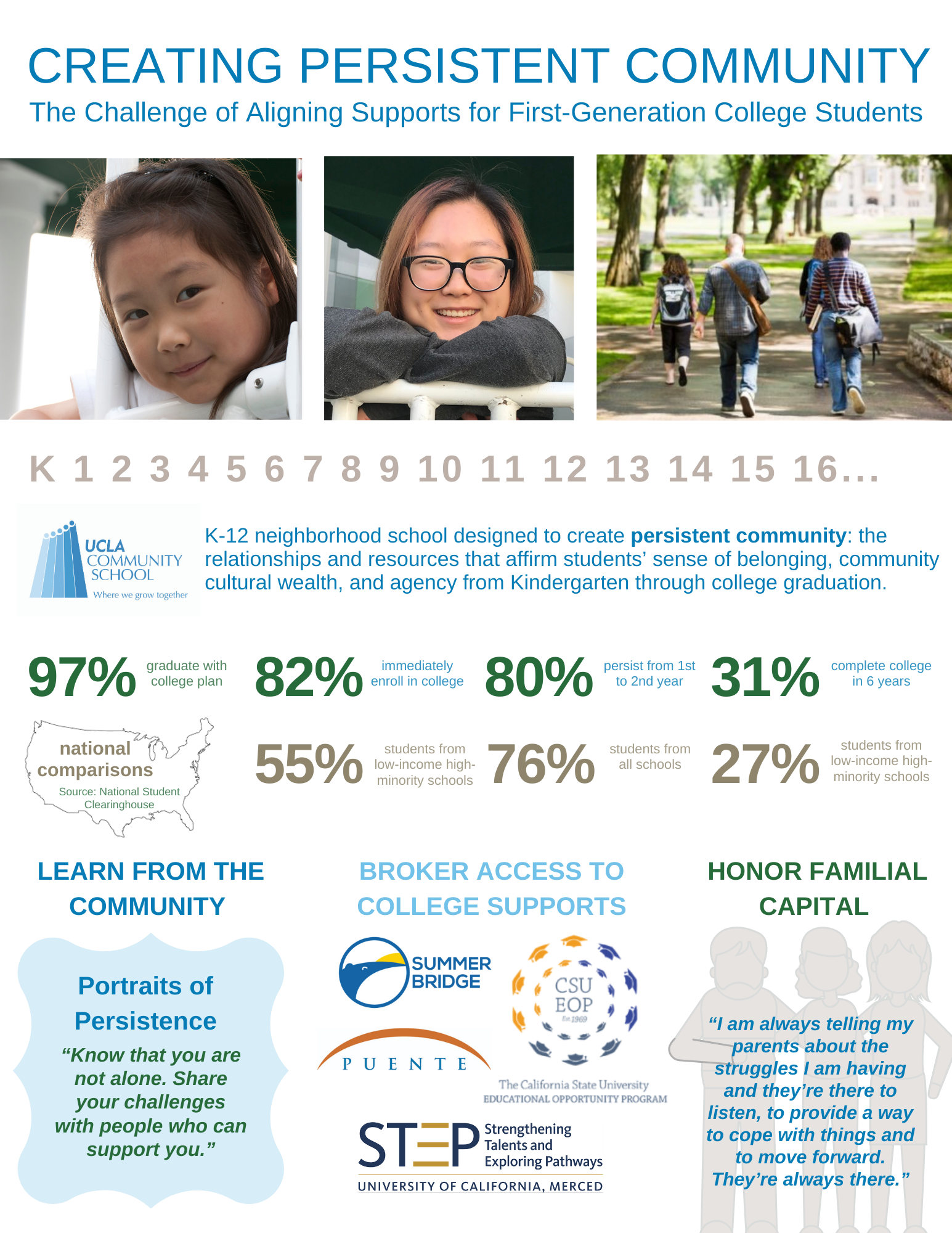
Introduction
The UCLA Community School (UCLA-CS) is a university-assisted community school established in 2009 as a partnership among the Los Angeles Unified School District (LAUSD), the University of California, Los Angeles (UCLA), and the local community. The school is part of an in-district reform effort and was developed just after LAUSD passed the “A-G For All” resolution, ensuring that all students enroll in the college preparatory courses required by California’s public universities. As a site of public scholarship, the school is studying the implementation of this policy and tracking its graduates in order to inform practice, ensure accountability to the community, and contribute to the larger knowledge base about broadening access to higher education.
Nationally, progress has been made in preparing first-generation college students to access higher education, yet only 27% of college-going students from low-income, high-minority schools graduate within six years. Research is now focused on the postsecondary pathways students take in order to help them make it both to and through college. This report is the school’s first effort to document these pathways and focus on college completion.
A Site of Public Scholarship
The UCLA Community School enrolls a diverse student body from the surrounding densely-populated neighborhoods west of Downtown Los Angeles: Koreatown, Pico-Union, and Westlake. The area has been home to generations of families who migrated from countries such as Mexico, South Korea, Guatemala, Honduras, San Salvador, Nicaragua, and the Philippines. With a high proportion of the local communities being foreign-born, many students come from households with different immigration statuses, who speak multiple languages, and are working-class. The student population is Latina/o/x (83%), Asian American or Pacific Islander (8%), Filipina/o/x, Black, and White. Including racial and ethnic diversity, UCLA-CS students have intersectional and multifaceted identities that include language-learner status, disability/ability status, socioeconomic status, gender identity, etc. The UCLA Community School embraces scholarship that acknowledges the diversity within each student and across the student body.
In 2015, the Governor of California recognized the UCLA Community School with an Innovation in Higher Education Award based on early evidence that this school-university partnership was creating a more effective pipeline to college and career success for first generation college-going students. As the data in this report indicate, the partnership has encouraged a stronger college-going culture, resulting in higher than average college enrollment and persistence rates. Yet, longitudinal data following five cohorts of students reveals the enormous challenges facing first generation students of color as they seek to graduate from college, contributing to the extensive evidence of this problem.
As a site of public scholarship, the UCLA Community School was established to help reshape the state’s K-20 public education system, aligning primary, secondary, and higher education in ways that would create what we are calling “persistent community” to support students traditionally underrepresented in higher education.
We define a persistent community as the relationships and resources that affirm students’ sense of belonging, community cultural wealth, and agency from Kindergarten through college graduation.”
Our definition of persistent community aligns with previous research focused on how students reconfigure their social networks and struggle to create new ones in college (Rios-Aguilar & Deil-Amen, 2012). This area of work is focused not only on getting students into college, but also getting them to graduation. It also recognizes the differences in experiences and needs first-generation college students require to navigate postsecondary education.
Who We Are
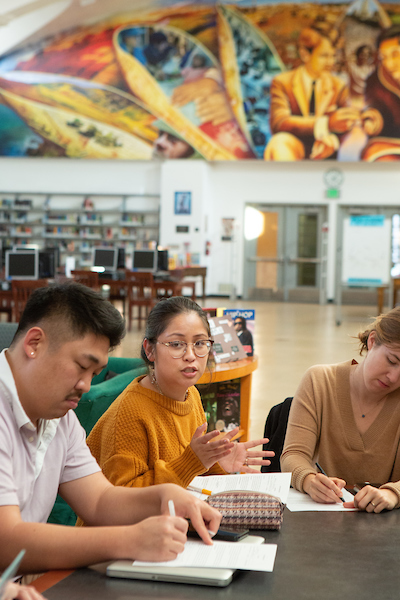
We are a group of researchers who have collaborated with educators at the UCLA Community School to better align college-going supports for students. We come together as part of a longstanding research-practice partnership (RPP) at the school focused on college access. We all have personal and professional connections to the work, and we all have played different roles in the College RPP. Karen Hunter Quartz, who has served as the school’s research director since 2009, has worked alongside graduate student researchers as part of the college RPP and together they have created a persistent community of support for research. Marco Murillo served as the school’s first graduate student researcher in 2010 focusing on the school’s college and career initiatives. Sidronio Jacobo, took over the college RPP graduate student researcher position in 2017 and worked closely to track the pathways alumni were traveling after graduation. In 2018, Victoria Amador joined the college RPP as an Alumni Fellow to help the school investigate the best ways to support college persistence. In addition to sharing her own postsecondary pathway in this report, Victoria contributed her expertise in social media and communications. Ariana Dimagiba is the most recent member of our community and currently serves as the college RPP graduate student researcher. We are thankful for the many teachers, counselors, administrators, and students who have collaborated on this research-practice partnership–convening with us in retreats, discussing data, tracking down alumni, and much more. In a sense, in the last ten years, we have developed our own persistent community–a community of scholars who uplift and support each other’s research to advance social justice.
About This Report
We have structured this report in three parts. The first sets the stage by sharing three stories, three “portraits of persistence.” You will learn about the pathways that co-author Victoria Amador and two other alumni have travelled since they left the UCLA Community School. Their stories contextualize the report’s main finding about the importance of persistent community. In part two, we turn to the data and describe the experiences, pathways, and outcomes of five cohorts of graduates. Part three steps back from these data to reflect on the challenge of creating persistent community. We situate our analysis in the literature and current policy context and close with the steps the school is taking next as well as broader recommendations for other schools and universities.
Part One: Portraits of Persistence
The following portraits of persistence share snapshots of alumni’s personal journeys in overcoming the challenges and barriers they faced in college. With each story that is shared we learn more about the situations they were placed in, the actions they took, and the results that led to their success. The common theme across these stories is the importance of taking the initiative to seek help and to find communities that can provide the support and guidance necessary to navigate through college. These experiences cultivate a new identity and a self-learning journey that can inspire and motivate future incoming college freshman students to share their college experiences as well.

Andrew Flores, Class of 2014
Andrew entered UCLA with a plan to become a doctor. He majored in psychobiology, intended to go to medical school and thought he had his life all mapped out. Although he enjoyed math and science, he soon learned that he didn’t see himself in those fields. He tried out several majors, including sociology, political science, and geography, but realized that he was more interested in the connections between different disciplines. In 2018–four years after graduating from the UCLA Community School–Andrew graduated with a B.A. in Latin American Studies.
The road to college graduation felt like an uphill battle at times. Andrew questioned his ability to be a college student and worried that he might be an imposter. As the first in his family to attend college, he knew he couldn’t afford to squander the opportunity and actively sought out help from campus counseling services, peer tutoring programs, and his professors. He learned to self-advocate, asking for extensions on papers when needed, and became an expert at managing his time. One of his main anchors was seeing other people of color on campus. The other was living at home, with the support of his family.
In his senior year, Andrew participated in UCLA’s undergraduate research week and experienced the intellectual rewards of exploring something that he was passionate about. This experience ignited an interest in graduate school and so once again he applied to UCLA–and only UCLA because he wanted to study with people that knew him well. In the fall of 2018, Andrew was accepted to the Master’s of Arts program in Latin American Studies. His research interests are LGBTQ+ rights, toxic masculinity, and migrant rights in Latin America with emphasis on Mexico and Central American countries.
To fund his college education, Andrew has relied on a combination of loans, grants, and scholarships. He has also held different jobs on campus, including teaching assistant and, most recently, director of communications for the UCLA International Institute’s Global Conference, Promoting Global Understanding. Looking back on his high school decision to become a doctor, Andrew reflected that it felt like “a way out,” a means to make money. “But then with time,” he shared, “I just realized I want this to be reciprocal, to give back in a way, but also figure out a way to succeed in life and professionally–and not be stuck doing the same old thing over and over again.” The global pandemic has focused his interest on global health and access to education.
Andrew’s advice for current UCLA Community School students: “There’s some stuff that you just have to learn from experiencing college. People in high school can warn you, they can tell you, ‘This is what you do. This is what you’re supposed to do.’ But at the end of the day, it’s your own journey to pursue.”

Mark Mendoza, Class of 2014
Mark enrolled at CSU Los Angeles to study nursing. Both of his parents worked as nurses and encouraged him to pursue a similar path. He initially followed in their footsteps because they were very encouraging and provided financial support. However, Mark soon realized that nursing was not his passion.
The summer after graduating from high school, Mark enrolled in remedial Math and English courses at his college. He passed both courses and felt the courses helped ease his college transition, but Mark was frustrated because they did not count toward his graduation requirements. In retrospect, he felt his high school could have provided more information about the college entrance exam and how it could impact his course taking trajectory. He shared: “taking two extra years of math and one extra year of English, I would say it held me back probably a quarter.” In the fall after high school graduation, he was a full-time student pursuing a nursing major and even completed a certificate program to be a nurse assistant. Mark struggled to adjust academically his first year. He recalled having difficulty keeping up with course material and how to study for exams: “My first quarter, the hardest things were where to study and what to study…So my first midterms I didn’t do so well because I didn’t know half of the class [content] was going to be put into one test. And I didn’t balance my time enough to study.”
Mark overcame his initial struggles by joining study groups. However, he was unhappy with his major and left CSULA. During his leave of absence Mark took a job as a restorative nurse. One day while waiting for his client, Mark stumbled across a notice for a science and technology conference and this re-ignited his passion for computer science, which began after taking a course in high school. By winter, Mark enrolled in a community college course to ease back into school: “I decided why not start off at community college so I could start walking before I start running. So once I took computer science in [community college] it helped me transition back into college.” Mark returned to his CSULA campus for the spring quarter, just as he was finishing his community college coursework. He was happy with his decision and although his parents were initially disappointed, they supported his new career goal in data security management.
Mark graduated from CSULA in 2018 with a B.S. in Information Technology and works as an Enterprise Resource Planning analyst at a tech company. Reflecting on his college experience he appreciated developing his skills to be competitive in the job market and growing as an individual: “You go to college for a better job. I always feel that’s the main purpose. [It] also helps you become a well-rounded individual… You’re not so biased with social issues…You’re more knowledgeable [about the world].”

Victoria Amador, Class of 2016
Victoria was accepted to two colleges in the Spring of 2016: CSU Los Angeles and California State Polytechnic University, Pomona. Although craving a change in scenery, she chose to save the costs of dorming, live at home, and attend CSULA. Four years later, amid the global pandemic, Victoria graduated online with a Bachelor’s degree in Communications. Her passion is connecting with others and giving back.
In high school, Victoria signed up for a college head start program run by the Central American Resource Network (CARECEN). In college, she stayed connected to this local non-profit by volunteering her time and helping others. This experience satisfied her college service requirement and reflected her core values: “As much as I have all this knowledge and I have my experience I’ve gained, what’s the point of having all of that if I can’t share it and support other people.” The idea of supporting her community and giving back is something she attributes to her family as well as the school’s social justice vision and tight-knit community. “It’s just the way that I’ve been experiencing life. It’s the reason I am who I am.”
Victoria has also experienced the power of receiving support from others. At the advice of her college counselor, she enrolled in the Educational Opportunity Program (EOP), met regularly with an advisor, had access to learning supports, and connected with other students. In her sophomore year, she branched out and joined the Student Health Advisory Committee on campus to help other students connect with resources. Victoria became a UCLA-CS Alumni Fellow in her third year to study and share how the school was preparing students to persist in college.
The challenge of persisting hit home in her senior year when Victoria’s family needed her to find a job to support an unexpected rent increase. She found a flexible job working in an Amazon warehouse, allowing her to complete her degree and help her family. She also found a mentor at Amazon that encouraged her to stay after graduation, move up the ladder, and explore the company’s work in communications. The summer after graduating, Victoria interviewed and received a job offer to become an assistant manager for Amazon. She is currently working in this position and continues to pursue her passion for social justice and giving back.
Victoria’s advice for students entering college is to reach out for help and embrace the power of connecting with others. “Know that you are not alone. Share your challenges with people who can support you.” Family has been Victoria’s biggest support: “I am always telling my parents about the struggles I am having and they’re there to listen, to provide a way to cope with things and to move forward. They’re always there.”
While Andrew, Mark, and Victoria persisted to and through college, most of their peers did not. We turn now to the data we collected on five cohorts of UCLA-CS alumni in order to understand the challenge of aligning supports for first-generation college-going students.
Part Two: Data on College Preparation, Outcomes, and Pathways
As a team of researchers and practitioners, we have documented the collective problem-solving process that unfolded over a decade, from 2007 to 2017, to establish a strong college-going culture at the UCLA Community School (Quartz, Murillo, Trinchero, Neri & Jacobo, 2019). We described three practical problems–how to frame, support, and track a college-for-all reform effort—and detailed how grappling with these problems locally provided unique insight into the larger college-for-all policy context. We explored the role of learning supports, status hierarchies, and resources in realizing the college-for-all ideal. We also articulated a fundamental framing tension between social justice as redistribution and recognition and suggested that the notion of parity of participation guide policy and action. To complement this paper, we released a data report in March 2019 that provided methodological information about how the school tracks and measures college-going: UCLA Community School Longitudinal College-going Data Report: College Plans, Enrollment, and Persistence of the Classes of 2014 to 2018. With this current report, we follow up on our prior analyses based on updated longitudinal tracking and survey data for the Classes of 2014 to 2020 (see the Appendix for more information).
College-Going Culture
Each spring, seniors complete a survey that captures their attitudes about the school’s college going supports, college choice concerns, and their college decisions. This survey was designed in partnership with UCLA’s Higher Education Research Institute (HERI) and the items on college decisions were taken from the Cooperative Institutional Research Program (CIRP) Freshman Survey. HERI’s CIRP Freshman Survey captures data on incoming students’ background characteristics, high school experiences, attitudes, behaviors, and expectations of college.

Student survey responses serve as important data to inform and strengthen the school’s college-going culture and are discussed at an annual partnership retreat each summer. Discussions are guided by the literature that identifies a school’s college-going culture with nine principles: (1) college talk, (2) clear expectations, (3) information and resources, (4) a comprehensive counseling model, (5) testing and curriculum, (6) faculty involvement, (7) family involvement, (8) college partnerships, and (9) articulation (McClafferty, McDonough, and Nunez, 2002). Taken together, these principles provide an integrated approach for creating a school culture in which college-going permeates the learning environment.
To understand the quality of the school’s college-going culture, we analyzed student responses on items related to the college-going culture principles. We analyzed responses from 580 students across seven graduating cohorts, from 2014-2020. Overall, 74% of students agreed or strongly agreed that the school provided support in the college application process and encouraged students to attend college (see Appendix for more details).
Students’ responses on college decisions revealed college affordability as the most salient concern with 82% of students either somewhat or very concerned with paying for college. This finding is consistent with the California State Aid Commission (CSAC) report on Cal Grant Modernization: A Vision for the Future, that found access to financial aid can be a barrier to students’ enrollment in college in California.
As an urban school, serving an high immigrant-origin population, concerns about documentation are also prominent. More than a quarter of students responded they were very concerned about legal status or being undocumented (28%). Research has noted a growing need for educational leaders to address immigration issues, in particular, in urban schools where educational leaders report encountering declines in academic performance and attendance (Ee & Gandara, 2020).
Lastly, the role of family and living close to home were important influences in students’ college choices with 60% of seniors reporting that their parents wanting them to attend a particular college was somewhat or very important. In contrast, only 17% of the national sample of students responding to the 2019 CIRP Freshman Survey expressed the same reason. Similarly, 63% of UCLA-CS seniors reported that living close to home was important to their college choice versus 25% of the national sample (Stolzenberg, Aragon, Romo, Couch, McLennan, Eagan, and Kang, 2020).
Postsecondary Outcomes
The UCLA Community School Research and Accountability Committee tracks the postsecondary success of UCLA-CS alumni using data from two databases: the UCLA-CS College Database and the UCLA-CS Postsecondary Pathways Database. The purpose of developing these databases is to capture students’ postsecondary trajectories, as suggested in the postsecondary pathways literature. This data report shares findings on alumni’s postsecondary pathways as measured by outcomes that are commonly reported in publications by postsecondary institutions as well as by federal and state government agencies. Since 2014, researchers and staff have collected and analyzed three outcome measures and/or phases to understand and assess alumni graduates’ postsecondary pathways: postsecondary educational plans, immediate college enrollment, and college persistence. This year, we add a fourth measure, college completion because the school’s first four-year cohort of students (Class of 2014) have reached their sixth postsecondary year.
Table 1 provides a snapshot of the findings for the four college outcomes measures. We report both the percentages provided by the National Student Clearinghouse (noted by an asterisk) as well as the percentages based on our follow-up data collection.
Table 1
Snapshot of UCLA Community School College-Going Data for Class of 2014-2020
| Graduate Class | n | Postsecondary Plans | Immediate Enrollment | 1st to 2nd Year College Persistence | College Completion |
| Class of 2014 | 75 | 96% | 75% (67%*) | 82% (83%*) | 31% (28%*) |
| Class of 2015 | 65 | 93% | 76% (54%*) | 78% (79%*) | – |
| Class of 2016 | 89 | 100% | 81% (74%*) | 85% (85%*) | – |
| Class of 2017 | 84 | 100% | 86% (72%*) | 82% (84%*) | – |
| Class of 2018 | 86 | 98% | 90% (76%*) | 73% (86%*) | – |
| Class of 2019 | 87 | 97% | 81% (75%*) | – | – |
| Class of 2020 | 111 | 96% | – | – | – |
| Total | 597 | 97% | 82% (70%*) | 80% (62%*) | 31% (28%*) |
| Note: (a)* is the percent reported from National Student Clearinghouse (NSC) StudentTracker. The total percentages were calculated based on data from the Class of 2014-2020, however, the school’s NSC StudentTracker Aggregate report includes two earlier cohorts, the Classes of 2012 and 2013. Graduates from these classes were not enrolled for four years at UCLA-CS. We have omitted these data for this reason. | |||||
The percentage of graduates planning to enroll in college has remained fairly constant with an average of 97% of all UCLA-CS graduates indicating they plan to enroll in a 4-year or community college. Through our data tracking of students’ college enrollment, 82% of all UCLA-CS graduates enrolled in college immediately after high school graduation. It is important to note the percentage of graduates who enroll in college immediately after graduation has fluctuated but has increased overall. Based on preliminary evidence from the National Student Clearinghouse (NSC), we expect the college enrollment rate for the Class of 2020 to dip further given uncertainty and hardship associated with the COVID-19 pandemic.
We found that UCLA-CS has higher rates of students enrolling in college immediately after high school compared to national rates of similar schools. In 2016 UCLA-CS had a college immediate enrollment rate of 81% in comparison to 55% for graduates of schools with a low-income, high-minority student population.
Table 1 also displays the first-year to second-year persistence rates for UCLA-CS graduates. On average, 80% of UCLA-CS graduates who enrolled in college immediately persisted into their second year. In comparison to LAUSD, state, and national rates UCLA-CS graduates persisted from their first to second year at higher rates for 2014-2016.
To capture college completion, the fourth college outcome measure, we focused on the cohorts of students who attended the school for at least four years, starting with the Class of 2014. The Class of 2014 had a six-year college completion rate of 31%. While national and district college completion rates for the Class of 2014 are not yet available, the NSC 2019 High School Benchmark report found 27% of students from the class of 2012 who graduated from low-income, high-minority schools completed college within six years. In contrast to similar schools, the school’s completion rate is slightly higher than the comparison for prior years for similar schools. While traditional measures of college completion look at six-year completion rates, the NSC tracks students for eight years after high school. The school’s earliest cohorts, Classes of 2012 and 2013, did not attend the school for four years and are therefore not included in this report. However, the NSC eight-year data shows that 13% of the Class of 2012 completed college in 6 years and an additional 19% completed in 8 years, bringing the completion rate to 32%. These data signal that a longer time frame for college completion should be considered in traditional measures.
Although there is strong evidence that students are persisting through their first year of college, our college completion rate illustrates there is a more nuanced story to college persistence. Our team conducted further analysis of the college enrollment records to track postsecondary pathways.
Postsecondary Pathways
In order to understand graduates’ postsecondary pathways, we analyzed the pathways of three cohorts of students (Classes of 2014, 2015, 2016) during their first four years after graduating from the UCLA Community School. Figure 1 displays these pathways, including a missing data pathway, as a set of flows. The width of the bands is proportional to the flow rate, which in this case starts with students’ postsecondary plans in their senior year of high school and follows them to their fourth year after high school graduation. This visual allows us to see how students “flow” from year to year, making transitions in commitments to enroll in and actual enrollment in four different types of colleges, defined by their institution type (UC, CSU, CC, and private). For example, while 48 of 52 (92%) students who committed to enroll at a UC school did so within the first year of graduating from college, only 72 or 101 (71%) of students who committed to enroll at a CSU did so.
Figure 1
Postsecondary Pathways, Classes of 2014, 2015, 2016 (n=229)
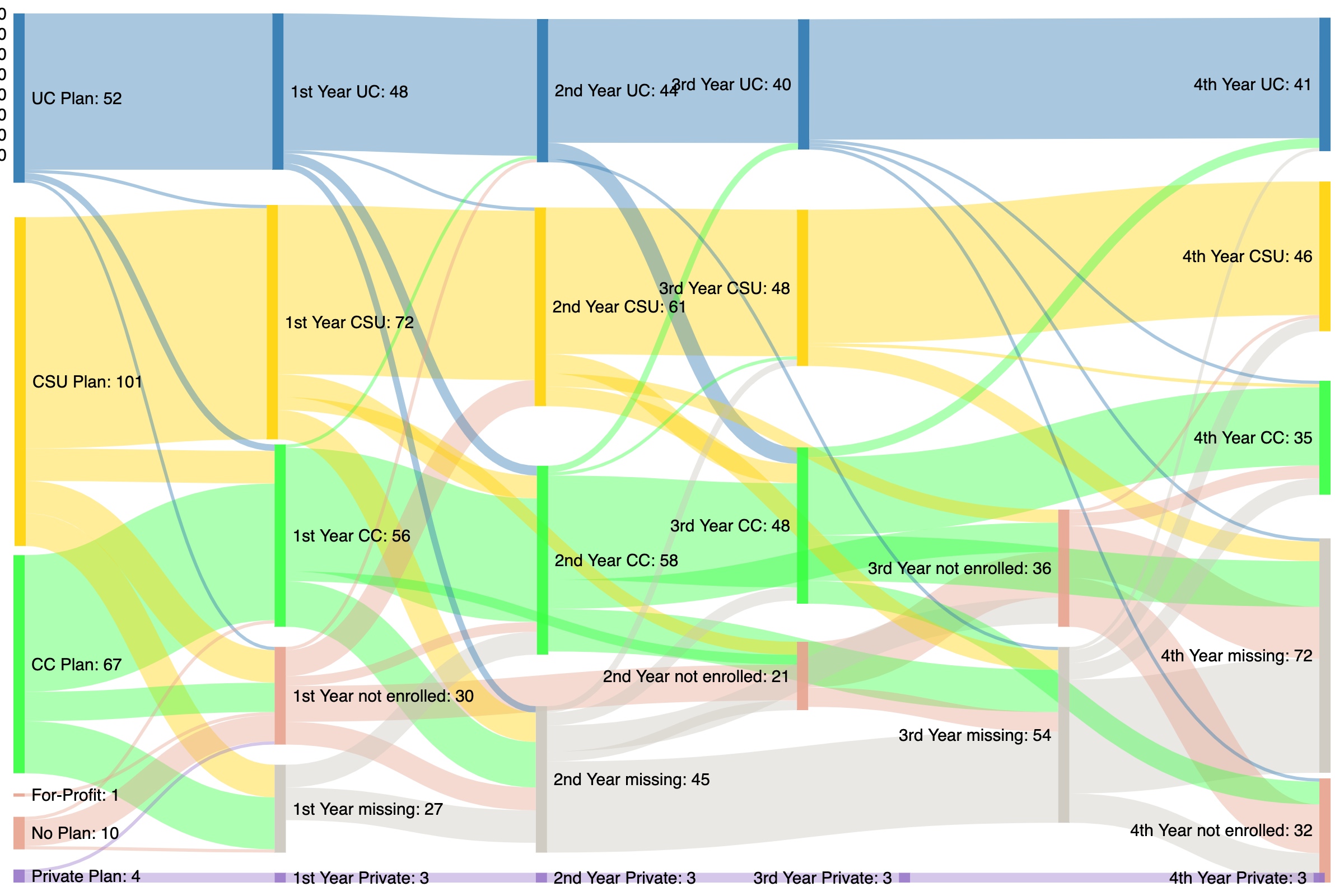
Two years after graduating from high school the trajectories among CSU and CC students have more variation than those who attended a UC. Figure 1 visualizes the non-linearity of these trajectories, or flows, from year to year as well as the declining college persistence rate. For example, only 46% of CSU students persisted to their 4th year compared with 79% of UC students. It is also notable that by the 4th year, we are missing records for 31% of alumni, particularly the students who originally planned to attend community colleges.
These data suggest that UCLA-CS graduates face enormous challenges in completing college. In order to understand and address these challenges, we have conducted follow-up interviews with alumni. Students face a range of challenges as they navigate postsecondary educational experiences, including academic adjustment, dealing with academic failure, gaps in college attendance, feeling pressure to succeed, and finding institutional and familial support (Murillo, Quartz, & Jacobo, 2019). We have also reflected on the school’s role in supporting students to persist. We now turn to the challenge and the potential of creating a persistent community.
Part Three: Aligning Supports to Create Persistent Community
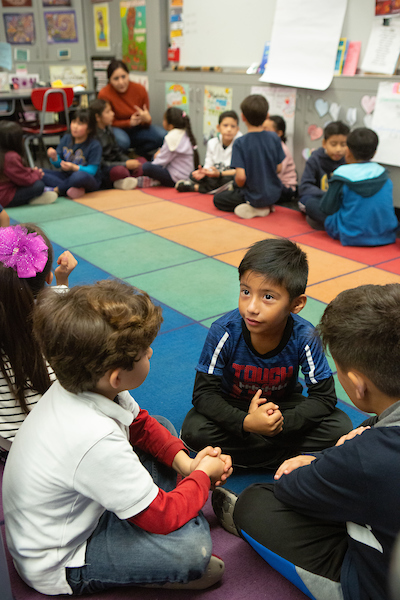
The UCLA Community School was designed as a K-12 span school in order to minimize disruptive school transitions and to create a nurturing and aligned educational experience–a sense of persistent community–for students from the age of 4 to 18. Less than 3% of California public schools are span schools and there is very little, if any, evidence regarding the effects of the sustained engagement offered by a K-12 grade span in an urban context. In contrast, there is extensive research on the effects of a positive and nurturing school climate on student achievement (Thapa, Cohen, Guffey & Higgins-D’Alessandro, 2013). We know that students who experience stable and trusting relationships in school are more likely to thrive than students who do not feel connected or supported. Based on longitudinal survey data from the LAUSD school experience survey, we also know that students at the UCLA Community School report higher than average connections to school and experience trusting and respectful relationships.
Based on the school’s experience over the past decade, we believe that creating a sense of stability and connectedness for students during their formative years will prepare them to stay connected to their community and value the importance of giving and receiving support as members of different communities as they become adults. However, given the challenges we know our alumni have experienced persisting through college, we are now asking questions about how the school can better prepare students to persist. We are exploring what it means to help students develop a sense of persistent community in college–a sense that they belong, are valued, are supported, and have the resources they need to succeed.
The New “To and Through College” Commitment
Current policy conversation focuses on the importance of supporting first-generation college students “to and through college.” This phrase is used widely to signify the importance of sustained support for students across their college-going journeys. For example, the University of Chicago’s To & Through Project provides research-based data on the educational experiences of marginalized youth and facilitates dialogue across stakeholder groups to advance more equitable outcomes. Similarly, the Education Trust’s Getting To and Through College series profiles and advocates for the pathways of first-generation college students. Both of these efforts offer tools and suggestions for high schools to better prepare students to persist through college, including offering advanced coursework, supporting students to earn good grades, and helping them choose the right college.
Alongside these recommendations to help high schools prepare students to persist, the current school accountability context has recently extended measures of the effectiveness of K-12 schools beyond high school graduation rates to college enrollment, persistence, and graduation rates. On one hand, this move may serve to better align K-12 and higher education systems through policies and practices that support shared college readiness expectations and assessments (Jackson & Kurlaender, 2016). On the other hand, it may advance the expectation that K-12 schools should be held accountable for their alumni’s college outcomes, which may be accompanied by the expectation that K-12 schools should invest in the lives of their students beyond high school graduation–to get them to and through college.
Several charter management organizations have taken up this charge and developed a range of alumni support programs (Whitmire, 2019). Not much is known about whether and how these K-12 alumni-support programs can improve college completion, but the growth of these programs presents an interesting opportunity to probe whether and how K-12 schools should assume responsibility for students no longer under their formal charge. And if so, what is the relationship between supports provided by K-12 schools and the many bridge and support programs provided by colleges and universities?
To gain a greater understanding of these issues, we conducted an exploratory internet search of “high school alumni support programs” and reviewed 30 K-12 alumni-support programs offered by accredited public schools. We mainly searched and observed programs supported by charter management organizations or networks of charter schools and found that many depended on dedicated personnel and/or funding. Some schools, for example, spend over $1,000 dollars per student for their alumni-support programs (Whitmire, 2019). We learned that schools with support for research and data-gathering infrastructures were also most likely to have alumni-support programs and report their college persistence and completion rates on public-facing websites. Based on our review of these programs, we identified eight common types of support offered by high schools, many of which emulate supports offered by higher education institutions:
- Dedicated Alumni Support Personnel
- Professional and Peer-to-Peer Mentorship Programs
- School-Based Employment and Internship Opportunities for Alumni
- Online Portals for Resource Sharing and Networking
- Alumni Scholarship and Loan Programs
- Alumni Social and Professional Event Programming
- Social Media Groups
- Alumni College-Enrollment Tracking Databases
Although only a cursory look at what seems to be a growing number of K-12 alumni support programs, these supports go beyond the traditional mission of primary and secondary schooling and require additional resources and investments. In addition, some of these supports mimic and duplicate supports already offered by colleges and universities.
Brokering Access to College Support Programs
Many K-12 schools–including non-charter public schools with college counselors–broker a selective form of alumni support when they encourage students to apply for private comprehensive scholarship programs, such as the Gates Millennium Scholarship Program, the Dells Scholars Program, the Posse Foundation Scholarship program, and the One Voice Scholars Program. In addition to financial resources, these programs provide mentors, networking opportunities, and a community to support students to and through college.
Similarly, many K-12 schools encourage their students to apply for public college bridge and support programs such as the Education Opportunity Program offered by the California State University, the Academic Advancement Program offered by the University of California, and the Puente program offered by the California Community Colleges. Previous research has shown some evidence that these programs provide positive impact in supporting first-generation students to persist through college (Ackermann, 1991; Hirano-Nakanishi, Garcia, and Walia, 2004; Winograd, Verkuilen, Weingarten, and Walker, 2018).
Asking the Right Questions
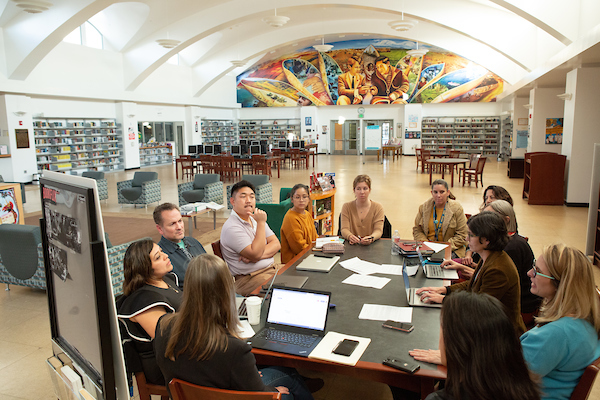
Question 1: What is the school’s responsibility and capacity to support alumni?
What is the relationship between college access and support programs at the K-12 and higher education levels? How are these programs aligned? What forms of alumni support can K-12 schools reasonably offer and manage with limited or no additional funds?
Although everyone at the retreat acknowledged their commitment and desire to help alumni persist through college, the issues of alignment and capacity kept surfacing. As we detailed in our paper on preparing all students for college (Quartz, Murillo, Trinchero, Neri & Jacobo, 2019), the work it takes to prepare first-generation students to apply to and be admitted to college is enormous and requires professional college counseling, strategic alliances with a myriad of programs and college-going resources, and a strong and supportive school culture with established college-going rituals, celebrations, and family engagement. Helping students apply to college support and scholarship programs falls within this work scope and the group discussed how to broaden the schools’ connection with these programs. We also identified opportunities to develop deeper relationships with the colleges and universities our alumni attend at the highest rates in order to help them access existing resources and support networks.
Question 2: How can the school support alumni given its capacity?
What is reasonable to expect given the school’s focus on current students? What supports can be provided and sustained with limited resources?
Acknowledging that the school’s primary focus must remain on current students, retreat participants discussed two low-cost strategies for supporting alumni: social media and informal alumni advisors.
Social Media
Social media tools can help schools support their alumni. The school can build on two existing social media platforms and networks: the Facebook UCLA Community School page and the LinkedIn UCLA Community K-12 group. There is value in extending these platforms to further inform and connect alumni to share important information on new opportunities and resources.
The UCLA Community School Facebook group currently has 528 members that are both current students and alumni. There are monthly postings created on the Facebook page that come from faculty and staff with status updates on class projects/trips, current events, and job opportunities.
There is an opportunity to further expand the school’s network and outreach through LinkedIn, a professional networking social media platform where alumni can provide updates on their education and career goals. It can also provide an opportunity for members to share insightful career tips and advice alongside job postings. UCLA Community School currently has an unclaimed LinkedIn group page with 64 members, both current students and alumni who are informally placed in a group because their profiles have UCLA Community School in their education information. To take it a step further, the school can establish a formal Alumni UCLA Community School LinkedIn account. This alumni group page can be created and claimed by an employee of the school and utilized to expand more career development opportunities. Offering this media space can assist alumni to expand and stay connected to the school’s network and community.
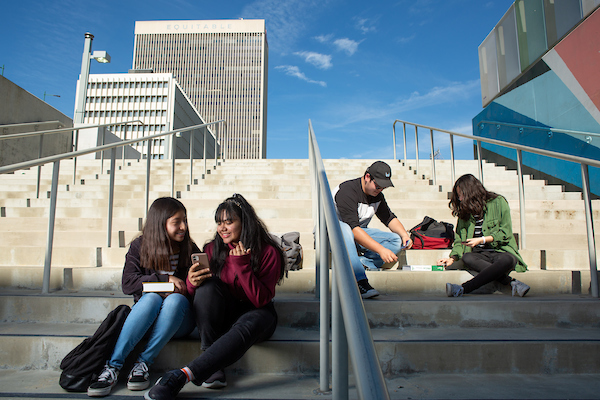
Informal Alumni Advisors
Each year, teachers and counselors informally reach out to alumni and invite them to serve as guest speakers while seniors are in the early stages of the college application process. Retreat participants discussed ways to continue to support this outreach and alumni engagement, including Q&A discussion boards to encourage student-alumni interaction–similar to college campus forum pages. Many of these forums are informal and do not require a designated individual(s) to respond to each question. Providing this space for discussion can create an extension to the LinkedIn group page.
Question 3: How can we create a persistent community?
How can K-12 schools create a sense of persistent community to sustain alumni through college? What is the role of school vision in preparing students to persist? What role does family play in supporting students to persist? And how can we lift up the stories of alumni who do persist to inspire others?
Focusing on the 4CCs
The UCLA Community School seeks to instill four core competencies in order to graduate all students as: (1) self-directed, passionate learners; (2) masters of academic content; (3) bilingual, biliterate and multicultural, and (4) active and critical participants in society. Retreat participants discussed how the instructional program and school culture that supports these competencies builds on students’ community cultural wealth and prepares them to approach the world confident in their own agency, connected to their community, and aware of the structural inequities they will have to navigate after graduating. In this way, the school is preparing students to persist as active and critical participants in society–aware of the challenges ahead.
Honoring Familial Capital
We know the families of first-generation college students play an important role in supporting their college aspirations and enrollment. Yet little attention has been given to the role of family in supporting these students once in college. As such we are beginning to understand how families support first-generation college students’ persistence in higher education. Our interviews with alumni have revealed that students’ families (parents, siblings, and extended family members) play a variety of roles while they navigate higher education. This includes offering moral encouragement, motivational and inspirational support, economic support, and navigational guidance. As more students from minoritized racial/ethnic, low-income, and immigrant-origin groups enter higher education, both K–12 and postsecondary schools must recognize and tap into their familial capital in ways that help build a foundation to enter, persist, and complete higher education.
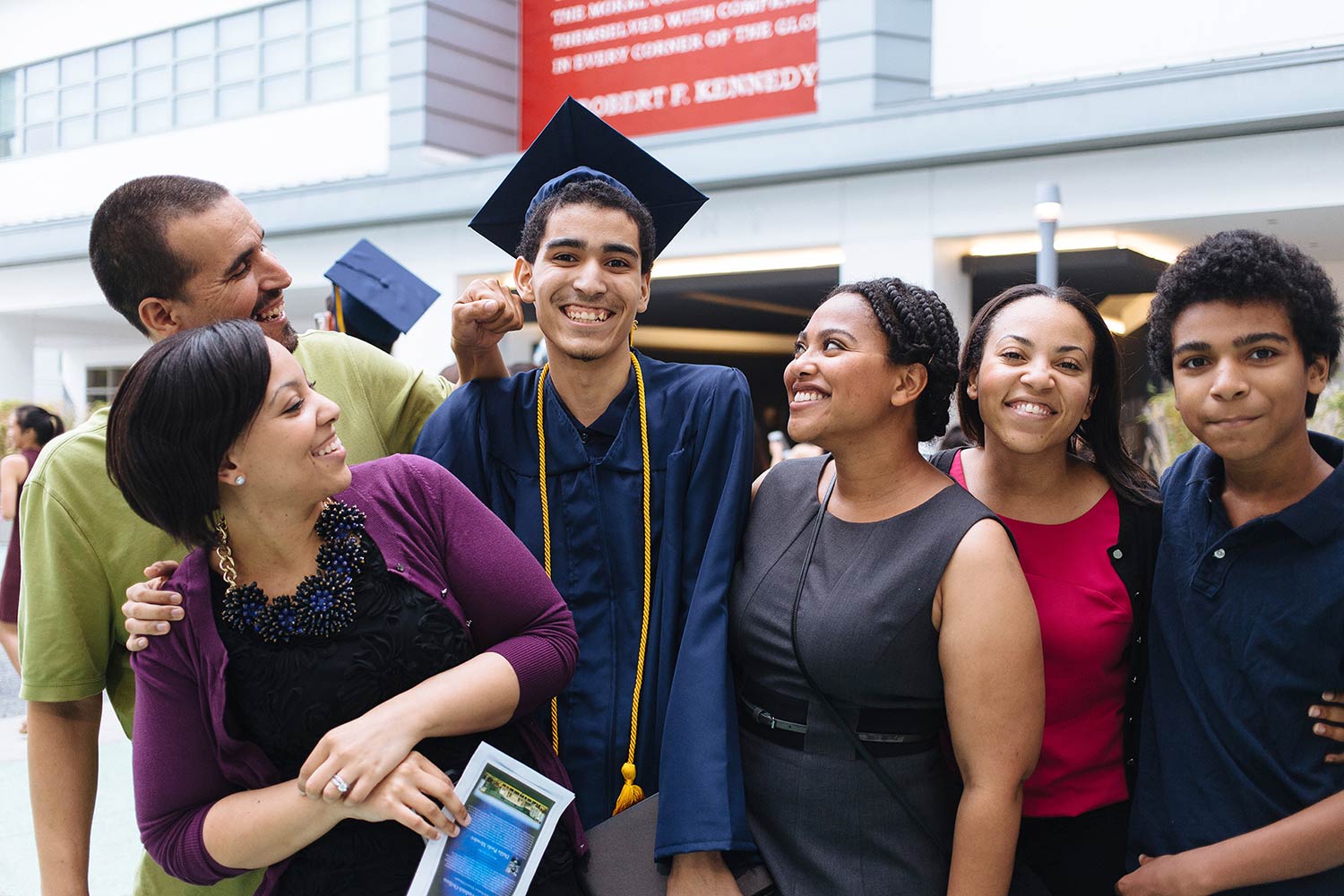
Creating Portraits of Persistence
Learning about the challenges students face in persisting through college is important, but addressing these challenges as a K-12 school community can feel intractable. Students who face economic hardship or experience institutional racism in college are up against pernicious and longstanding societal inequities. We have much to learn from the successes and the struggles of graduates who persist through college. To this end, retreat participants agreed on the value of creating a series of narratives–portraits of persistence–to shape the way K-12 students think about their future and approach college persistence.
Conclusions and Recommendations
The UCLA Community School was created to take on the challenge of aligning primary, secondary, and tertiary education to support students traditionally underrepresented in higher education. This report has documented the school’s strong college-going culture and a set of key college outcome measures. Based on longitudinal data from these measures, we have provided evidence that UCLA-CS alumni are enrolling and persisting in college at higher than average rates. We have also documented fluctuations in community college versus 4-year college enrollment and a recent decline in persistence rates. Through an analysis of college pathways, we learned that the trajectories among CSU and CC students have more variation than those who attended a UC, and that only 46% of CSU students persisted to their 4th year compared with 79% of UC students. For the first time, we have also reported college completion rates, which are similar and slightly higher than national data for low-income, high-minority schools but far below the national average.
We discussed how these data have sparked collective inquiry and problem solving among school and university partners–framed by the notion of “persistent community,” which we define as a stable set of relationships that affirm students’ sense of belonging, community cultural wealth, and agency from Kindergarten through college graduation. Our inquiry helped us identify a set of alumni supports that extend our school community–using social media and alumni advisors. We also revisited the role of our core competencies to prepare students to persist and the crucially important persistent community that families create for students. Finally, we offered an initial set of portraits of persistence to uplift and inspire our own students. Based on our collaborative inquiry, we offer the following recommendations for other K-12 schools as well as colleges and universities.
For K-12 schools:
- Recognize the challenges your alumni will face and prepare them to understand and navigate these challenges by belonging to a persistent community of supporters, including their family. Broker access to the wide variety of supports and programs offered by colleges and universities.
- Critically assess your school’s capacity to support alumni and contextualize the press to establish K-12 alumni support programs within the larger effort to emulate higher education supports within a competitive educational marketplace. Based on your analysis, develop contextually appropriate and sustainable supports that extend the reach of your school community.
- Learn from your own community. Lift up the stories in your community of alumni who have persisted to provide models and support for your K-12 students.
For colleges and universities:
- Affirm the community cultural wealth of first generation college students, including their linguistic assets and familial capital, and support campus communities, clubs, and programs that honor students’ many assets (e.g., UCLA’s First to Go, UC Merced First and Proud).
- Nurture stable and supportive partnerships with K-12 schools that send cohorts of alumni to your colleges and universities (e.g., San Diego State University’s Compact for Success, Long Beach College Promise).
- Expand access to support and transfer programs and ensure students can stay connected to these programs over time (e.g., CSU Educational Opportunity Program, UC Merced STEP Program, LATTC Puente Program).
References
Ackermann, S. P. (1990). The benefits of summer bridge programs for underrepresented and low-income students. College and University, 66(4), 201-208.
Alspaugh, J. W. (1998). The relationship of school and community characteristics to high school drop-out rates. The Clearing House: A Journal of Educational Strategies, Issues and Ideas, 71(3), 184–188. https://doi.org/10.1080/00098659809599356
California Department of Education: Data and Statistics (2019). College going rate report (2017). [Data set] California Department of Education. https://www.cde.ca.gov/ds/sd/sd/cgrinfo.asp
California Department of Education: Data and Statistics (2019). College going rate report (2016). [Data set] California Department of Education. https://www.cde.ca.gov/ds/sd/sd/cgrinfo.asp
California Department of Education: Data and Statistics (2019). College going rate report (2015). [Data set] California Department of Education. https://www.cde.ca.gov/ds/sd/sd/cgrinfo.asp
California Department of Education: Data and Statistics (2019). College going rate report (2014). [Data set] California Department of Education. https://www.cde.ca.gov/ds/sd/sd/cgrinfo.asp
Coladarci, T., & Hancock, J. (2002). Grade-span configuration. Journal of Research in Rural Education, 17(3), 189–192.
Dove, M. J., Pearson, L. C., & Hooper, H. (2010). Relationship between grade span configuration and academic achievement. Journal of Advanced Academics, 21(2), 272–298. https://doi.org/10.1177/1932202X1002100205
Dynarski, S. M., Hemelt, S. W., & Hyman, J. M. (2015). The missing manual: Using National Student Clearinghouse data to track postsecondary outcomes. Educational Evaluation and Policy Analysis. 37(1), 53S-79S.
Ee, J., & Gándara, P. (2020). The impact of immigration enforcement on the nation’s schools. American Educational Research Journal, 57(2), 840-871.
Fiaschetti, C. F., & Slate, J. R. (2014) Differences in student achievement by grade span configuration for students who were economically disadvantaged. Journal of Education Research, 8(4).
Hirano-Nakanishi, M., Garcia, P., & Walia, M. (2004). Educational Opportunity Program fall 1995-96 cohort brief. Retrieved October 21st, 2020 from https://www2.calstate.edu/attend/student-services/eop/Documents/EOP_Persistence-Brief-2004.pdf
Huie, F., Ryu, M., and Shapiro, D. (2020). Completing college state report (signature report 18A). National Student Clearinghouse Research Center. https://nscresearchcenter.org/wp-content/uploads/Completions_Report_State_Feb2020.pdf
Iloh, C. (2018). Toward a new model of college “choice” for a twenty-first-century context. Harvard Educational Review, 88(2), 227-244.
Jackson, J., & Kurlaender, M. (2016). K–12 postsecondary alignment and school accountability: Investigating high school responses to California’s Early Assessment Program. American Journal of Education, 122(4), 477–503. https://doi.org/10.1086/687273
Jacobo, S., & Quartz, K. H. (2019). UCLA Community School longitudinal college-going data report. UCLA Center for Community Schooling. https://communityschooling.gseis.ucla.edu/ucla-community-school-longitudinal-college-going-data-report/
Kiyama, J.M., and Rios-Aguilar C. (Eds.). (2018) Funds of knowledge in higher education: Honoring students’ cultural experiences and resources as strengths. New York: Routledge.
Los Angeles Unified School District. (n.d.) College Persistence. LAUSD OpenData Dashboard. Retrieved August 22, 2020 from, https://my.lausd.net/opendata/dashboard#
Liou, D. D., Antrop-Gonzalez, R., & Cooper, R. (2009). Unveiling the promise of community cultural wealth to sustaining Latina/o students’ college-going information networks. Educational Studies, 45(6), 534-555
McClafferty, K. A., McDonough, P. M., & Nunez, A.-M. (2002). What is a college culture? Facilitating college preparation through organizational change. Paper Presented at the annual meeting of the American Educational Research Association. New Orleans.
McFarland, J., Hussar, B., Wang, X., Zhang, J., Wang, K., Rathbun, A., Barmer, A., Forrest Cataldi, E., and Bullock Mann, F. (2018). The condition of education 2018 (NCES 2018-144). U.S. Department of Education. Washington, DC: National Center for Education Statistics. https://nces.ed.gov/pubsearch/pubsinfo.asp?pubid=2018144.
McFarland, J., Hussar, B., de Brey, C., Snyder, T., Wang, X., Wilkinson-Flicker, S., Gebrekristos, S., Zhang, J., Rathbun, A., Barmer, A., Bullock Mann, F., and Hinz, S. (2017). The condition of education 2017 (NCES 2017-144). U.S. Department of Education. Washington, DC: National Center for Education Statistics. https://nces.ed.gov/pubsearch/pubsinfo.asp?pubid=2017144.
Murillo, M. A., Quartz, K. H., Jacobo, S., (2019). Examining postsecondary pathways: Capturing the diversity of students’ high school and college experiences. Paper presented at the annual meeting of the American Educational Research Association. Vancouver, CA.
National Student Clearinghouse Research Center (2016). High school benchmarks: National college progression rates. Virginia, CA: National Student Clearinghouse. https://nscresearchcenter.org/wp-content/uploads/HighSchoolBenchmarks2016.pdf
National Student Clearinghouse Research Center (2017). High school benchmarks: National college progression rates. Virginia, CA: National Student Clearinghouse. https://nscresearchcenter.org/wp-content/uploads/2017HSBenchmarksReport-1.pdf
National Student Clearinghouse Research Center (2018). High school benchmarks: National college progression rates. Virginia, CA: National Student Clearinghouse. https://nscresearchcenter.org/wp-content/uploads/2018_HSBenchmarksReport_FIN_22OCT18.pdf
National Student Clearinghouse Research Center (2019). High school benchmarks: National college progression rates. Virginia, CA: National Student Clearinghouse. https://nscresearchcenter.org/wp-content/uploads/2019_HSBenchmarksReport_FIN_04OCT19.pdf
National Student Clearinghouse Research Center (2020). Snapshot report: First year persistence and retention. Virginia, CA: National Student Clearinghouse. https://nscresearchcenter.org/wp-content/uploads/PersistenceRetention2020.pdf
Perna, L. (2006). Studying college access and choice: A proposed conceptual model. In J. C. Smart (Ed.), Higher education: Handbook of theory and research. 21: 99-157.
Perna, L. W., & Jones, A. P. (Eds.). (2013). The state of college access and completion: Improving college success for students from underrepresented groups. New York City, NY: Routledge.
Perez, P. & McDonough, P. (2008). Understanding Latina and Latino college choice: A social capital and chain migration analysis. Journal of Hispanic Higher Education. 7(3): 249-265.
Phillips, M., Yamashiro, K, & Jacobson, T. (2017). College going in LAUSD: An analysis of college enrollment, persistence, and completion patterns. Los Angeles, CA: Los Angeles Education Research Institute.
Quartz, K. H., Murillo, M. A., Trinchero, B., Colina Neri, R., & Jacobo, S. (2019). Framing, supporting, and tracking college-for-all reform: A local case of public scholarship. The High School Journal, 102(2), 159–182. https://doi.org/10.1353/hsj.2019.0004
Rios-Aguilar, C., & Deil-Amen, R. (2012). Beyond getting in and fitting in: An examination of social networks and professionally-relevant social capital among Latina/o university students. Journal of Hispanic Higher Education. 11(2), 179-196.
Roderick, M., Coca, V., & Nagaoka, J. (2011). Potholes on the road to college: High school effects in shaping urban students’ participation in college application, four-year college enrollment, and college match. Sociology of Education, 84(3), 178-211.
Shapiro, D., Ryu, M., Huie, F., Liu, Q., & Zheng, Y. (2019). Completing college 2019 national report (signature report 18). National Student Clearinghouse Research Center. https://nscresearchcenter.org/wp-content/uploads/Completions_Report_2019.pdf
Solórzano, D., Datnow, A., Park, V., & Watford, T. M. (2013). Pathways to postsecondary success: Maximizing opportunities for youth in poverty. Los Angeles: CA: UC/ACCORD. https://pathways.gseis.ucla.edu/publications/PathwaysReport.pdf
Stolzenberg, E. B., Aragon, M. C., Romo, E., Couch, V., McLennan, D., Eagan, M. K., & Kang, N. (2020). The American freshman: National norms fall 2019. https://www.heri.ucla.edu/monographs/TheAmericanFreshman2019.pdf
Thapa, A., Cohen, J., Guffey, S., & Higgins-D’Alessandro, A. (2013). A review of school climate research. Review of educational research, 83(3), 357-385.
The Education Trust (2020). Getting to and through college. Retrieved October 1st, 2020 from https://edtrust.org/getting-to-and-through-college/
Urban Education Institute (2020). The to and through project. Retrieved October 1st, 2020 from https://toandthrough.uchicago.edu/
Whitmire, R. (2019). New numbers show low-income alumni of KIPP schools are graduating college at 3-4 times the national average; alumni of Alliance, Aspire & Green Dot schools also above average. LA School Report. http://laschoolreport.com/new-numbers-show-low-income-alumni-of-kipp-schools-are-graduating-college-at-3-4-times-the-national-average-alumni-at-alliance-aspire-green-dot-schools-also-above-average/
Winograd, G., Verkuilen, J., Weingarten, A., & Walker, L. (2018). Educational Opportunity Program (EOP) at a selective public university: Initial findings from a longitudinal evaluation study. Learning Assistance Review, 23(1), 61-93.
Appendix: Measuring College Going Culture and College Outcomes
Traditionally, research on postsecondary pathways posits student success can be examined as a longitudinal process of four major phases: college readiness, college enrollment, college achievement, and post-college attainment (Deil-Amen & Turley, 2007; McFarland, Hussar, Wang, Zhang, Wang, Rathbun, Barmer, Forrest Cataldi, & Bullock Mann, 2018; National Student Clearinghouse Research Center, 2018; Perna, 2006; Perna & Jones, 2013; Solórzano, Datnow, Park, & Watford, 2013). These phases have been studied in multiple contexts, with different sample sizes and tools, across student sub-populations, and through diverse conceptual models, yet several outcomes measures remain popular (Dynarski, Hemelt, Hyman, 2013; Iloh, 2018; Perez & McDonough, 2008; Phillips, Yamashiro, & Jacobson, 2017; Rios-Aguilar & Deil-Amen, 2012; Roderick, Coca, & Nagaoka, 2011). For example, college readiness is often measured in terms of a student’s academic preparation, college knowledge, and college aspirations (Kiyama & Rios Aguilar, 2018; Liou, Antrop-Gonzalez & Cooper, 2009). Research on college achievement has examined students’ well-being, their satisfaction with college, or their ability to persist and graduate from college (McFarland et al., 2018; National Student Clearinghouse Research Center, 2018; Solórzano et al, 2018).
This appendix presents an in-depth analysis of the school’s college-going culture and the four college outcome measures based on data from the annual student survey and longitudinal data. The first section includes a detailed look into data from the annual survey distributed in the spring as described in the main report. The following section presents an in-depth analysis of the four college-going measures.
College-Going Culture
Figures 2-4 describe the responses on survey items related to the college-going culture principles from the survey seniors take in the spring. Items in Figure 1 capture students’ experiences of the school’s college-going supports. Overall, these data indicate that most students (59% to 74%) agreed or strongly agreed that they were supported in their college application process. For example, 74% of students agreed or strongly agreed that they felt supported by their teachers when applying for college. Additionally, 74% of students agreed or strongly agreed that all students are encouraged to attend college, felt included in school-hosted events when applying to college, received help on writing their personal statements, and felt supported by their counselor when applying to college. In contrast, only 60% of students agreed or strongly agreed that they felt supported by their parents when applying to college. Similarly, 59% of students agreed or strongly agreed that they received information needed to make decisions about which college to attend. Overall, students’ responses on these items indicate that most students experienced a range of college-going supports and that there is room for improvement.
Figure 2
Survey Responses on School College-Going Supports, 2014-2020
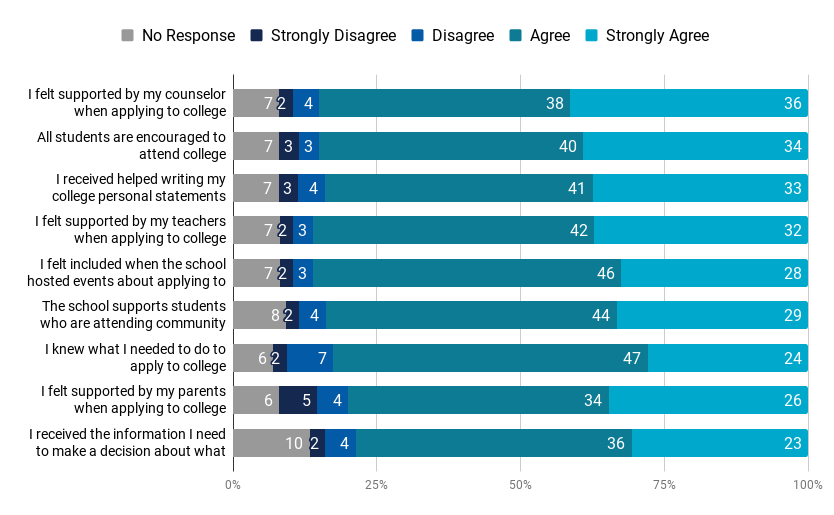
Figure 3 presents student concerns about committing to the college they chose to attend in the fall after graduation. These concerns include college affordability, first-generation status, family responsibilities, undocumented status, and English language learner status. Students were most concerned about college affordability with 82% of students either somewhat or very concerned with paying for college. Students also expressed that their first-generation status (61%) or being the first in their family to go college (58%) were important concerns in choosing what college to attend. A smaller percentage of students responded they were very concerned about not having papers/being undocumented (28%). There is the possibility this last concern regarding undocumented status is under-reported because 33% of students did not respond to this item.
Figure 3
Survey Responses on College Choice Concerns Aggregate for Class 2014-2020

Figure 4 displays the influences that UCLA-CS seniors’ reported in choosing the college they planned to attend in the fall after graduation. These influences include college affordability, college reputation, geographic proximity to home, family, and advising they received from the school. Similar to the survey items relating to college finances in Figure 2, 87% of students reported that college affordability was the most important reason for choosing a college. Another example of the saliency of college finances on college decisions is that 81% of students responded that receiving financial aid was somewhat or very important. It is also notable that the role of family and living close to home were influences in students’ college choices: 60% of seniors reported that their parents wanting them to attend a particular college was somewhat or very important. Living close to home was an important factor for 63% of UCLA-CS seniors.
Figure 4
Survey Responses on College Decisions, 2014-2020

College Outcomes
As mentioned in the report, we collect longitudinal data to track UCLA-CS graduates postsecondary pathways. In our past report, UCLA Community School Longitudinal College-going Data Report College Plans, Enrollment, and Persistence of the Classes of 2014 to 2018, we analyzed disaggregated data for three of the four college outcomes. For this iteration, we report limited disaggregated data.
The school contracts with the National Student Clearinghouse (NSC), a non-profit organization that provides college-enrollment data on college students across most colleges and universities in the United States. The NSC provides aggregated and detailed reports three times a year (Fall, Spring, and Summer) on college enrollment for up to eight years after a student’s high school graduation. The reports include demographic information such as enrollment by gender, race/ethnicity, socio-economic status, and other variables. The detailed report provides in-depth data on individual students’ college enrollment term-by term and per institution of attendance. While the NSC aggregate report may not provide detailed information about each student’s college enrollment, the aggregate report may still include a student’s enrollment status.
For example, the 2017 April Aggregate Report stated in 2015-2016 the NSC did not have information for 14 students out of 75 while the detailed report did not have information for 21 students. The NSC states students may be missing from both aggregated or detailed reports due to non-coverage. Non-coverage is defined as FERPA block, non-matching (typographic inaccuracies or errors), or the university/college does not submit data to the NSC.
One group whose college enrollment may be particularly underreported is undocumented students who are more difficult to track because they may lack a Social Security Number.
In response to the missing data from the NSC reports, the research team collects follow up data from alumni who are missing from the NSC data due to non-coverage. Multiple approaches to data collection are used, including surveys and individual follow-ups conducted with teachers, counselors, and other staff personnel. We include follow up data for each cohort to supplement data on college immediate enrollment, persistence and completion data tracked by the NSC.
Postsecondary Plans
UCLA-CS uses students’ postsecondary enrollment plans to calculate a “college-going rate.” Since 2014, UCLA-CS has collected data on graduating seniors’ college application process, including submissions, acceptances, and commitments. Postsecondary educational plans are collected by the school through student surveys, check-ins throughout the school-year, and informal “exit interviews” conducted by the college counselor.
Figure 5 summarizes graduates’ postsecondary plans to attend two-year and four-year colleges. The percentage of graduates planning to enroll in college has remained fairly constant with over 93% of students every year who plan to enroll in a four-year or community college. However, the proportion of students enrolling in two- versus four-year colleges has fluctuated. Disaggregating postsecondary plans data by gender reveal that female students consistently plan to attend four-year colleges at higher rates than male students.
Figure 5
Postsecondary Educational Plans, 2014-2020

Source: Data for the postsecondary educational plans are from UCLA-CS
Immediate College Enrollment
The college immediate enrollment measure is the annual percentage of high school graduates who enroll in two- or four-year colleges in the fall immediately following high school (McFarland et al., 2018). UCLA-CS uses this definition to measure the second college-going outcome.
Figure 6 highlights immediate college enrollment rates for the graduation cohorts 2014-2019 (N=595). Since 2014, the percentage of students who enroll in college the fall immediately after graduation has fluctuated but increased overall. In 2014, 74% of the graduating class enrolled immediately in college, in 2018 the rate peaked at 90%, and in 2019 the rate dipped to 79%. Each year, female students have enrolled at higher rates to four-year colleges immediately after high school in comparison to male students. It is important to note, between 2014 and 2018, there was a steady increase in Latino/a/x students who immediately enrolled in college but this number dipped in 2019.
Figure 6
Immediate College Enrollment, 2014-2019
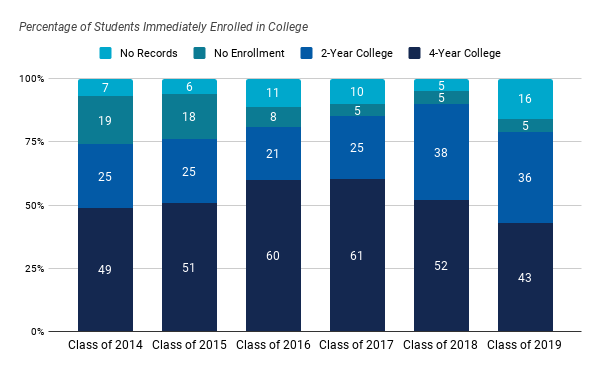
Source: Data for immediate college enrollment are from National Student Clearinghouse StudentTracker and UCLA-CS
As Figure 7 displays, UCLA-CS has higher rates of students enrolling immediately after high school compared to district, state, and national rates. In 2018, 91% of students enrolled in a four-year or community college immediately after high school, while LAUSD graduates enrolled at a rate of 68%. Similarly, in 2017 California high school graduates enrolled in college immediately after high school at a rate of 64%.
In order to provide a more accurate comparison of UCLA-CS immediate college enrollment rates with national rates, Figure 6 also includes national sub-group data prepared by the NSC High School Benchmarks 2019 report. This report provides college enrollment data on public non-charter schools based on school-level demographics and geographic characteristics. It is important to note that data provided by the NSC is not composed of a nationally representative sample but includes a sample of 4 million students from public and private high schools. We compare the school with these national data from the NSC’s High School Benchmarks Report, but note that our data includes both the NSC Student Tracker report as well as our own follow-up data collection.
For comparison purposes, we include student enrollment rates for urban schools, differentiated by income and minority enrollment. The NSC classifies schools as “low-income” if at least 50% percent of their students are eligible for free and/or reduced-price lunch. High-minority schools are defined as schools with at least 40% of students who are Black or Latino/a/s.
As Figure 7 illustrates, the school’s immediate college enrollment rate is higher than both national sub-groups: students attending low-income, high-minority schools and high-income, low-minority schools. In 2016, 81% of UCLA-CS graduates enrolled in a four-year or community college. In comparison, 55% of students graduating from low-income-high minority schools enrolled in four-year or community college in 2016.
Figure 7
Comparison of Immediate College Enrollment Rates for 2016: UCLA-CS and National Low Income-High Minority

Source: National data from National Student Clearinghouse High School Benchmark Report (2017)
College Persistence
The college persistence rate measures the percentage of students who immediately enrolled in fall and persisted into their second year for the measure persistence. Figure 8 describes the first-year to second-year persistence rates for UCLA-CS graduates from cohorts 2014 to 2018. For the Class of 2014, 46 out of 56 (82%) students persisted into their second year, while for the Class of 2015, 38 out of 49 (78%) students persisted into their second year of college. There was an increase in the persistence rate for the Class of 2016, with 61 out of 72 (85%) students persisting into their second year of college. However, subsequent years have seen gradual decline in college persistence rates. In the Class of 2017, 59 out of 72 (82%) students persisted into their second year of college. For the Class of 2018, 57 out of 78 (73%) of graduates persisted into their second year.
Figure 8
First-year to Second-year Persistence Rates, 2014-2018
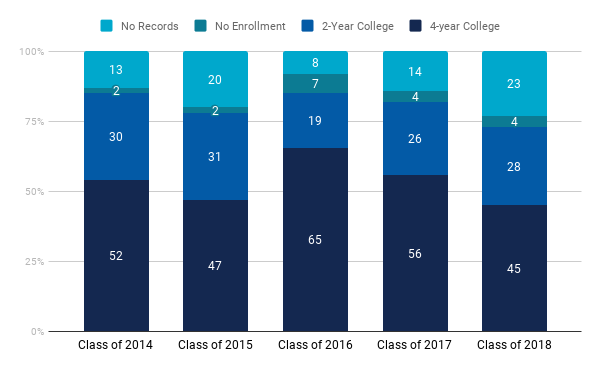
Source: Data for first- to second-year persistence are from National Student Clearinghouse StudentTracker and UCLA-CS
The next figure compares UCLA-CS rates of persistence with district, state, and national data. Similar to our comparison for immediate college enrollment, our data for college persistence includes records from the NSC and our follow up data collection. Based on available data maintained by LAUSD on students’ college persistence for 2014-2016, UCLA-CS graduates persisted from their first year to second year at higher rates than their LAUSD peers for 2014-2016 cohorts. College persistence rates for 2017 and 2018 cohorts are not yet available from LAUSD OpenData Dashboard. In order to compare UCLA-CS students’ first- to second-year persistence rates with state and national groups we used data provided by the NSC’s Persistence and Retention 2019 Report. We also acknowledge the NSC Persistence and Retention report is not a nationally represented sample but provides the most accurate comparison. For 2014-2016, UCLA-CS graduates persisted at slightly higher rates than students in California and nationally. However, in 2018 UCLA-CS graduates persisted at a slightly lower rate than students in California and nationally.
Figure 9
College Persistence Comparison Rates: School, District, State, and National

Sources: LAUSD data from LAUSD OpenData Dashboard, state data from California Department of Education (CDE) College-Going Report, and national data from National Student Clearinghouse High School Benchmark Report (2019). LAUSD OpenData Dashboard currently does not have college persistence rates for 2017 and 2018 cohorts.
College Completion
The college completion rate measures the percentage of students who graduate from a four-year or two-year college within six years after high school graduation. Only associates, bachelor’s and advanced degrees are counted in these rates. Certificates are not included. While there are different methods to measure college completion outcomes we decided to measure college completion in this method in order to use accurate comparisons with the NSC High School Benchmarks Report and LAUSD college completion rates.
Our alumni research has focused on the cohorts of students who attended the school for at least four years, starting with the Class of 2014. Yet, there are two additional cohorts of graduates who entered the school when it opened in 2010 as sophomores and juniors and graduated two and three years later in 2012 and 2013, respectively. These cohorts’ completion records have been tracked by the NSC but we have not conducted follow-up data collection. We report their completion rates below as a baseline to contextualize the rates of our four-year cohorts, starting with the Class of 2014.
As shown in Table 2, UCLA-CS’ first two classes (2012 and 2013) had college completion rates of 14% and 22% respectively, which are lower than the LAUSD rate of 25% in the same years. The school’s Class of 2014 had a completion rate of 31%. In order to understand these data in comparison to other students, Table 2 includes a national comparison rate for all students based on the NSC Completing College 2019 report. In order to provide a more accurate comparison with UCLA-CS college completion rates, Table 2 also includes national sub-group data prepared by the NSC 2019 High School Benchmark report which indicates that 27% of students in the class of 2012 completed college within six years We compare the school with these national data but note that our data includes both the NSC Student Tracker report as well as our own follow-up data collection for Class of 2014. For Class of 2012 and 2013 we used only data collected by the NSC. Although we do not have district or national comparison data for the Class of 2014, the school’s completion rate is slightly higher than the comparisons for the prior years.
Table 2
UCLA-CS, District, and National 6-Year College Completion Rates, 2012-2014
| 2012 | 2013 | 2014 | |
| UCLA-CS | 14% | 22% | 31% |
| LAUSD | 25% | 25% | – |
| National (NSC, 2019a) | 58% | 60% | – |
| National, Low Income – High minority (NSC, 2019b) | 27% | – | – |
Source: Data for LAUSD from LAUSD OpenData Dashboard; (a) National data from National Student Clearinghouse Completing College Report 2019; (b) Data for national Low-Income-High Minority from National Student Clearinghouse High School Benchmark Report (2019)
Although the six-year college completion rate is an important indicator, the NSC captures students’ postsecondary data for eight years. As Figure 10 below indicates, this longer time horizon allows us to see an increase in college completion for the Classes of 2012 and 2013. Of particular note, the college completion rate for the Class of 2012 almost doubled from year six to year seven (13% to 25%). Also of note, the four-year completion rate for the Class of 2016 is higher than the previous years, perhaps signifying future increases in the six-year completion rate.
Figure 10
College Completion Rates, 2012-2016
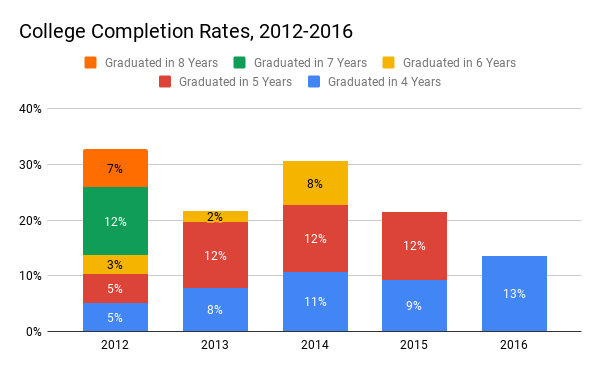
Note: Data for Class of 2012 and 2013 includes data provided by the NSC StudentTracker only, while 2014-2016 includes both NSC StudentTracker and follow-up data collected by UCLA-CS
About the Authors
Karen Hunter Quartz, Ph.D.
Karen Hunter Quartz directs the UCLA Center for Community Schooling and is a faculty member in the UCLA School of Education & Information Studies. Her scholarship examines community school development, teacher autonomy and retention, and educational reform. Professor Quartz led the design team in 2007 to create the UCLA Community School and served in 2017 on the design team for a second site, the Mann UCLA Community School. She currently oversees a portfolio of research-practice partnerships at both schools designed to advance democracy, inquiry, and change.
Ariana Dimagiba, M.A.
Ariana Dimagiba is a doctoral student at the UCLA School of Education and Information Studies in the Higher Education and Organizational Change division. As a graduate student researcher for the Center of Community Schooling, Ariana currently supports the College Going Research-Practice Partnership with the UCLA Community School. Her research interest focuses on minoritized students access and transitions to college. She holds a BA in Political Science and MA in Higher Education and Organizational Change from UCLA. Prior to returning to UCLA, Ariana was a college advisor for a college access program in Chula Vista, California.
Sidronio Jacobo, M.A.
Sidronio Jacobo is a doctoral student in the Higher Education and Organizational Change division at the UCLA School of Education and Information Studies. Born and raised in the Pico-Union and Westlake neighborhoods of Los Angeles, Sidronio has appreciated working with the UCLA Community School and UCLA Center for Community Schooling over the last three years. His dissertation will explore the implementation of large-scale educational reform at community colleges in California. Sidronio holds a BA in Social Welfare and Latin American Studies from UC Berkeley and a MA in Higher Education and Organizational Change from UCLA.
Marco A. Murillo, Ph.D.
Marco A. Murillo is Director of Strategic Initiatives at Santa Clara University’s Department of Education and Counseling Psychology. His research interests examine the secondary and postsecondary educational experiences of minoritized and immigrant students, focusing on systemic supports that promote college access, preparation, and completion. He holds a BA in political science and history from the University of California, San Diego, and a PhD in education (urban schooling) from the University of California, Los Angeles
Victoria Amador, B.A.
Victoria Amador is a UCLA Community School Alumni Fellow and a graduate of California State University, Los Angeles with a BA in Communications. Her professional interests are public relations and social media marketing. She is seeking to develop a career in social media consulting.
REPORT LINKS
CITATION
Quartz, K.H., Dimagiba, A., Jacobo, S., Murillo, M.A., & Amador, V.(2020). Creating persistent community: The challenge of aligning supports for first-generation college-going students. Los Angeles, CA: UCLA Center for Community Schooling.

